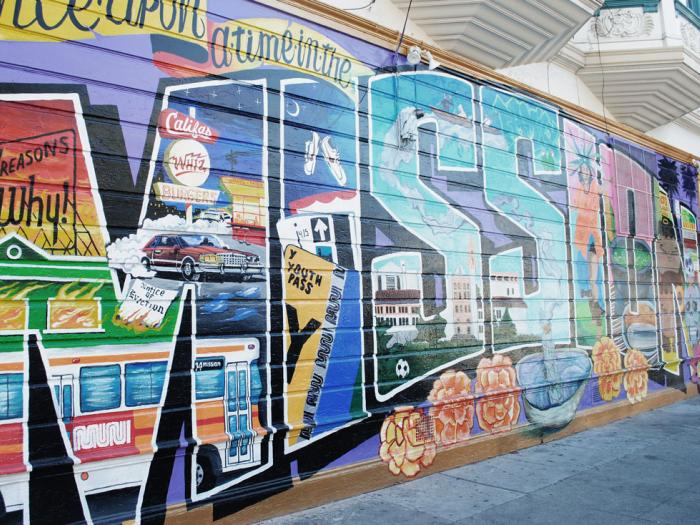
Mission Action Plan 2020
Project Status: Completed
MAP 2020 is now Mission Action Plan 2030
MAP2020 has moved to its next phase: Mission Action Plan 2030. This webpage is for archive purposes only and will not be updated.
The Mission Action Plan 2020 was endorsed by the Planning Commission on March 2, 2017.
The Plan identifies potential solutions for the residents, arts organizations, nonprofits and businesses being displaced by the rapid changes in the Mission.
Most strategies in the Mission Action Plan 2020 are currently under implementation, specifically:
- Implementation or acceleration of the shorter-term(6-12 month) items related to tenant business and nonprofit protection programs (most of which are not legislative in nature)
- Continued enforcement and commenced process improvement measures
- Supported the completion of the Calle 24 Special Use District process:
- Board File No. 170028 amended the Planning Code to create the Calle 24 Special Use District, generally bounded by 22nd Street, Potrero Avenue, Cesar Chavez Street, and Capp Street, as well as 24th Street to Bartlett Street.
- Continued the advancement and priority-processing of affordable housing projects in the pipeline
- Implemented the Commission’s Mission 2016 Interim Controls and extended the Controls on the Mission Corridor while hosting numerous meetings with project sponsors and community advocates to discuss project advancement and consistency with MAP2020 goals.
- District Supervisor Ronen also introduced additional Interim Controls for Restaurant uses while permanent legislation is being completed.
- Adopted amendments to the Planning Code related to Production, Distribution and Repair (PDR) protection and Mission Street Commercial Corridor legislation:
- Board File No. 170156 includes amendments to the Planning Code and Zoning Map to further protect and promote Production, Distribution and Repair (PDR) zones and uses.
- Board File No. 171173 amended the Planning Code to allow arts activities, remove non-retail professional services, and limits lot mergers on Mission Street.
- Board File No. 180803 amended the Planning Code to help protect and promote small neighborhood-serving retail establishments and balance the amount of alcohol-serving establishments.
The Mission District has a long history of cultural diversity. Historically, it has been a working class neighborhood largely comprised of low to moderate income households. Located in east-central San Francisco, the Mission District has had the City’s highest concentration of Latinos and immigrants from Latin America for decades. Rich with nonprofit service providers, cultural institutions, small legacy businesses, and working-class jobs in the Production, Distribution and Repair (PDR) sector, an unintended consequence of a rebounding economy following the Great Recession has been the devastating acceleration of displacement affecting many long-time residents and businesses.
MAP2020, a community-initiated effort, began in 2015 as a collaborative process between community advocates, including the Mission Economic Development Agency (MEDA), Dolores Street Community Services/Mission SRO Collaborative, SF Tenant Unions, Cultural Action Network— and long-time neighborhood activists from Plaza 16, Pacific Felt Factory, and the Calle 24 Latino Cultural District, and City staff to identify potential solutions for the residents, arts organizations, nonprofits and businesses being displaced by the rapid changes in the Mission.
Myriad factors are accelerating the rate of displacement within the neighborhood and it will take a variety of approaches and tools from both within City agencies and amongst community organizations to decelerate the displacement trend.
Draft Plan Objectives
MAP2020 has focused on developing solutions to advance the following objectives:
- Maintain the socio-economic diversity of the neighborhood by stabilizing the low and moderate income households at 65 percent of the total households.
- Protect tenants at risk of eviction and preserve existing housing, particularly rent-controlled apartments and single-room occupancy hotels.
- Increase the proportion of affordable units, compared to market rate units, planned and under construction to balance the housing mix.
- Stem the loss of and promote community businesses, cultural resources, and social services serving low to moderate income households.
- Increase economic security by strengthening educational and economic pathways and job opportunities for low to moderate income individuals and families, especially those without a college education.
- Retain and promote Production, Distribution and Repair (PDR) and other high-paying jobs for entry level and limited skilled workers.
Strategies
The collaboration developed an extensive list of possible solutions to the housing crisis under the following categories, the detailed solutions are in the report:
- Tenant Protections & housing access: keeping people in their homes
- Housing Preservation: retain affordable housing stock
- Housing Production: Building new housing for low to moderate income households
- Economic Development: Keeping jobs, business, artists & nonprofits in the neighborhood
- Funding resources: explore and add funding source
Your participation is important to this process. Please share your comments and questions anytime by reaching to the contacts listed to ensure that we are creating an effective and complete roadmap to help stem displacement and protect the cultural and economic diversity of the Mission.
Participants
Several City agencies and organizations have participated in the process to date such as the ones below (there have been many others not listed and others will be added as requested):
- Office of Mayor London Breed
- Office of D9 Supervisor Hilary Ronen
- Office of former Mayor Edwin M. Lee
- Office of former Supervisor David Campos
- Mission Housing Development Corporation
- Residents and members of Plaza 16 Coalition
- Dolores Street Community Services (DSCS) / Mission SRO Collaborative
- San Francisco Planning
- Mayor’s Office of Housing and Community Development (MOHCD)
- Health Services Agency (HSA)
- Department of Building Inspection (DBI)
- San Francisco Rent Board Office and Economic and Workforce Development (OEWD)
- Cultural Action Network (CAN)
- The Day Laborer Program and Women’s Collective
- Mission Economic Development Agency (MEDA)
- PODER
- Mission Neighborhood Centers
From the beginning of this process, MAP 2020 participants have met regularly and conducted focus groups and presentations to propose and discuss the extensive list of possible solutions and strategies that appear in the draft report.
